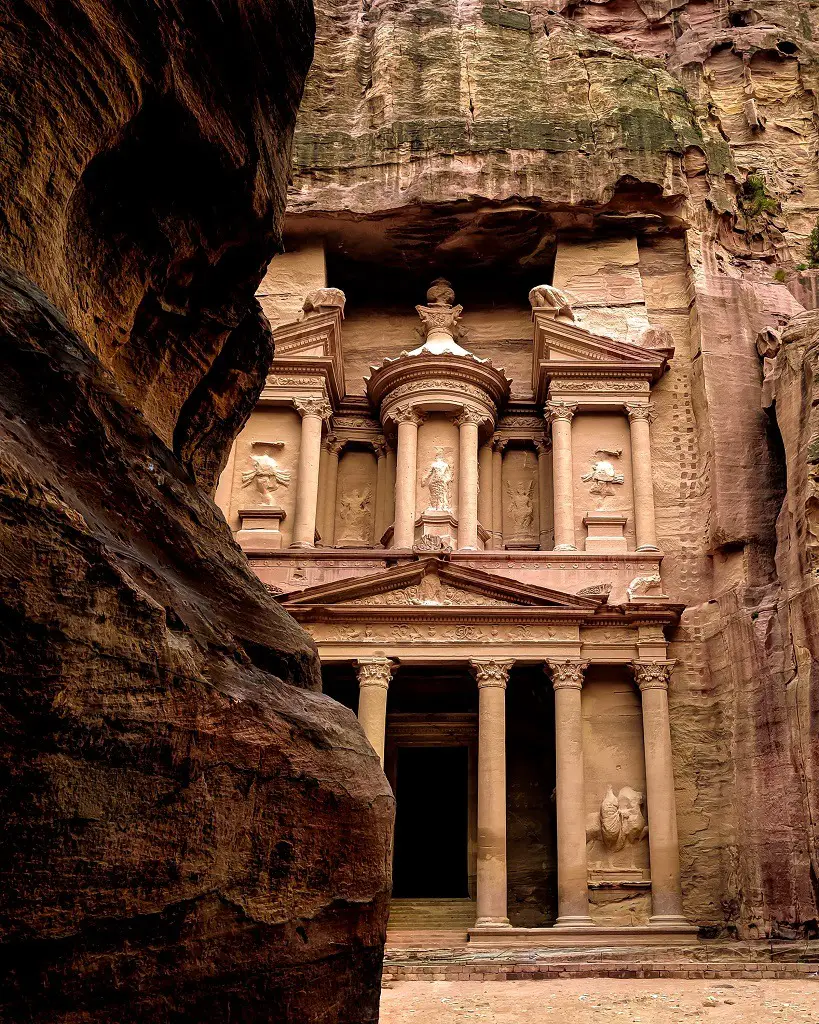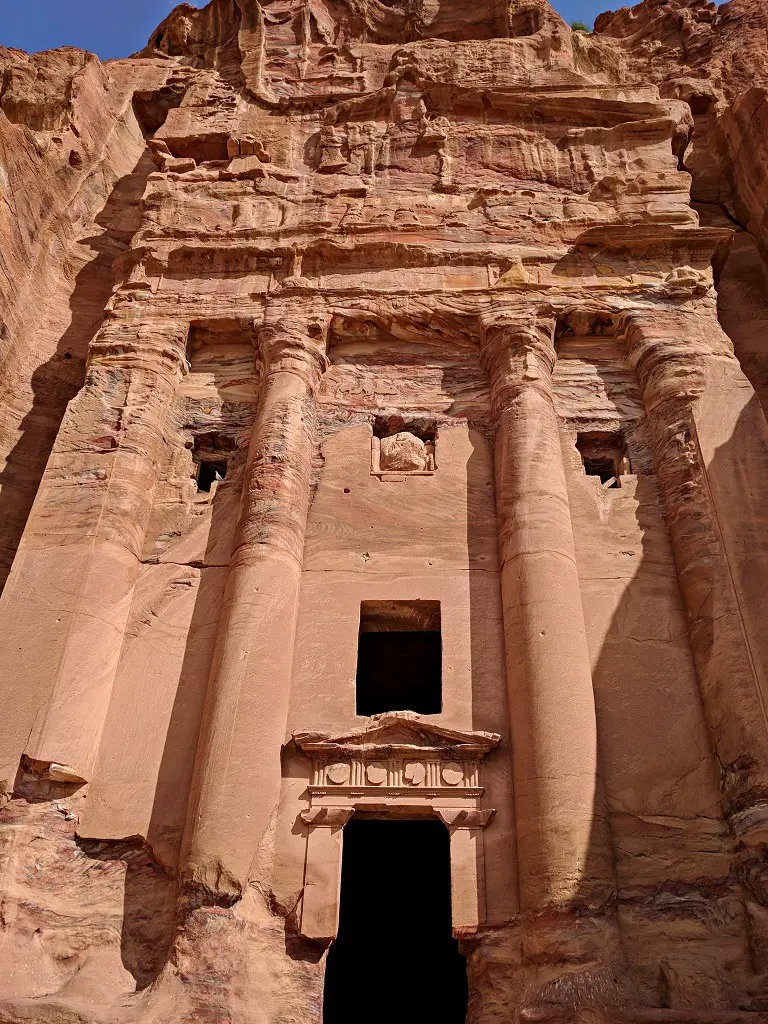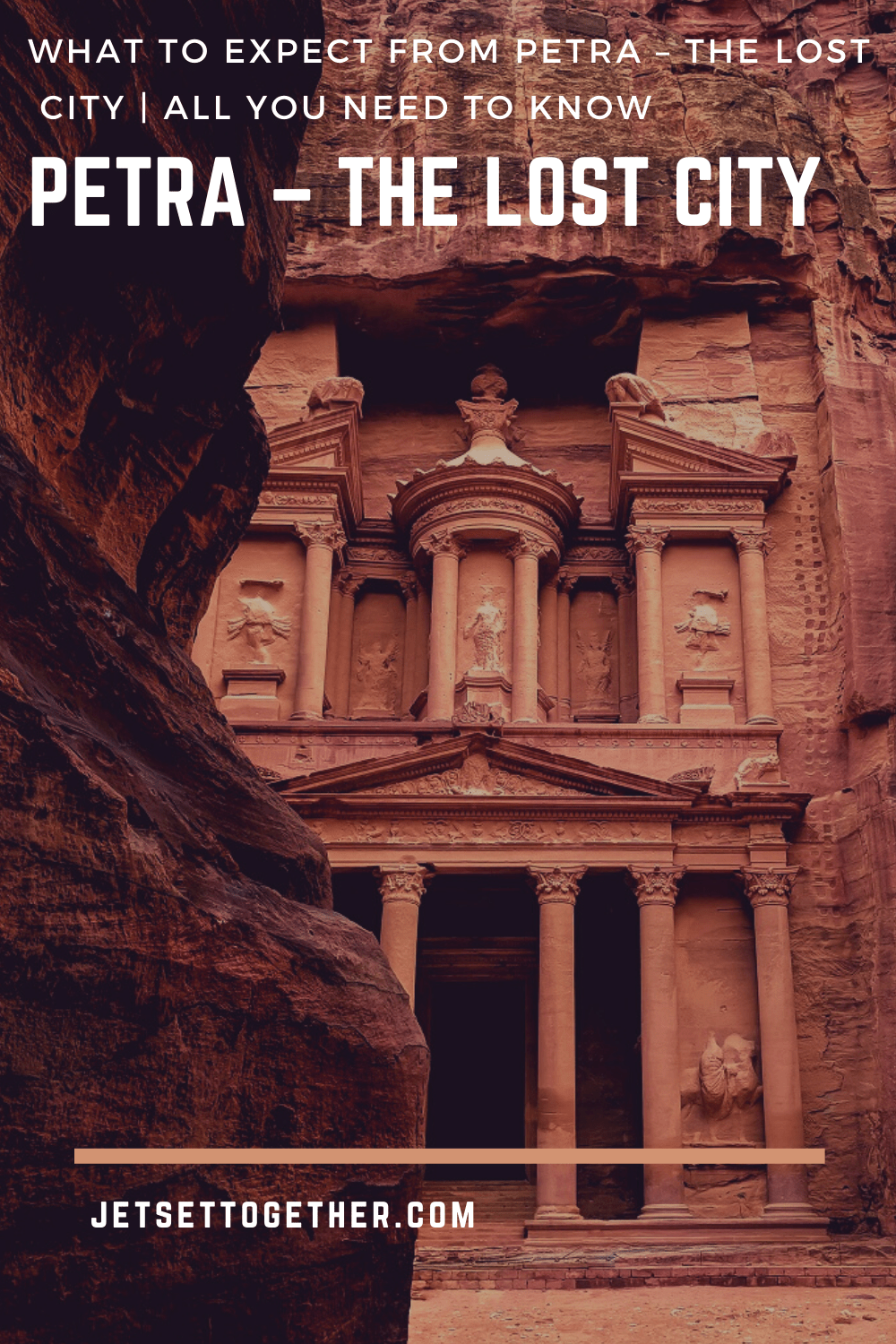What To Expect From Petra – The Lost City | All You Need To Know

Raqum, the Rose city, or the Lost city. All these names tell you about a unique place in the Jordanian desert – The Lost City of Petra. Why is it called a lost city if we know about it? Well, it is because from the 7th century until the 19th century (1812) the city was lost, and only traveling Bedouins knew about its existence. So, who built Petra and how did it become ‘lost’? In this article I am going to explain a little about the history of Petra, as well as what to expect from Petra when you visit the lost city yourself.

How Did Petra Become A Lost City
Petra was built by a people called Nabataean, who inhabited the area around Petra. Later they built Petra as a capital to their kingdom sometime between the 4th and the 2nd century BC. Petra became an extremely important city in the trade world. Naturally, people from everywhere were going through this city.

I know what you think. How can people survive there in a dessert and managed to build such constructions? Well, as the tale says, Nabataeans were very crafty people. They were good at stone carving (duh…) and they created a unique water system that collected rainwater which allowed them to develop agriculture. Archaeologists say that Petra had artificial pools and ponds and the city was not red but green. It is hard to imagine now how Petra looked during its best time. Although, even now you can see the remains of the water system all the way through al-Siq.

Since Petra was built on one of the important trading roots, it is no wonder that city was rich, and many people were passing through. So how did such a great city get erased from the map? The answer is simple, the trade root changed and there wasn’t a need to cross through the dessert anymore, so with time the city emptied. Plus, in 363 a big earthquake destroyed a large part of the buildings and damaged the water system.

Planning Your Trip To Petra
If you want to go to the lost city of Petra, but don’t know how to plan your trip click here to read my article on How To Get To Petra. If you already planned it all, I still want to give you a few tips.

First of all, do wear super comfortable shoes! Remember that you are going to walk for many hours through literally a rock city. You will step on rocky sand most of the trip, so it is best if the shoes have a foamy, springy base. In this case you will not hurt your feet.

Bring sunglasses and a hat. Petra is a city located in the desert and you will need some protection from the sun. Even if it is a wintertime (Cody and I visited Petra in February) do bring a hat and sunglasses. It can be very windy there, and I guarantee that dust will get into your eyes without sunglasses.

If you are planning to travel to Petra during the cold winter, bring warm clothes with you. Although in February, the temperature was between 10°C and 15°C, due to the strong cold wind, I got very cold (was wearing a hoody, jeans and a windbreaker).
At Petra’s Entrance
In case you forgot to bring a hat or sunglasses, you can by all those things at the entrance to Petra. There are lots of vendors that offer warm clothes like socks, gloves, hats, and scarves, plus you can buy headscarves, souvenirs, and other small things.

I already told you that I got very cold, so at the entrance I bought myself a pair of long socks. Of course, everything is super overpriced there which is why it is better to just bring with you some extra warm clothes (at least in wintertime).
Siq

For those who have been to Antelope Canyon in America, Siq will look similar, although the Antelope Canyon was formed by water and the Siq by tectonic force. However, over time water smoothed the walls of the Siq. The Siq canyon is 1.2 km long

The Siq is the main entrance to the lost city of Petra and one of the most amazing parts of the whole Petra experience. It is a very narrow canyon, sometimes not more than 3 meters wide and 90 -180m meters tall. Can you imagine this if you close your eyes and place yourself there? How small do you feel? I must say that going through the Siq was my favourite part of the trip. Why? Well, Petra was on my must-do list ever since I was seven. Try to imagine that excitement I had going through the narrow magnificent canyon, feeling myself as a discoverer of Petra. And finally getting to the point where you can see a part of the Treasury (Al Khazneh).

But don’t be mistaken, the Siq is not just empty rock walls that lead to the entrance of Petra. Along the canyon you will notice lots of people’s carvings as well as natural creations. One of those is a stone Elephant made by nature. Well, you know what they say, “nature is the best artist”.

As soon as you will step on the path to Petra through the Sig, pay attention to your left. There you will see an Obelisk tomb. It is probably called that because the form of stone carvings. On the top of the tomb there are four obelisks. The Obelisk tomb is the first tomb you will see in Petra.

Going deeper into the canyon just in general pay attention to the rocks and you will notice lots of stone carvings that at one point meant something important to Nabataean people. If you, like us, will have a tour guide, most likely he will point out all these things to you.

Amazingly, through the whole canyon stretches the amazing water system that you can easily notice carved into the mountains. The archaeologists noticed that this narrow recess was covered, and it looked more like a pipe. Fascinating, don’t you think?

The Treasury (Al Khazneh)

It is the most recognized structure from the lost city of Petra, and it is located at the Bab as-Siq, the square at the end of the Siq canyon. It is the Treasury which was futured in the movie “Indiana Jones and the Last Crusade” and it is the Treasury that attracts people to come to Petra in the first place.

The Treasury or Al Khazneh is believed to be a tomb of one of the kings of the Nabataeans. The name “Treasury” stuck to this tomb when in the early 19th century the Bedouins thought that the tomb contains treasure. Even now you can see bullet holes on the walls and especially on the urn at the top of the tomb. The Bedouins hoped that shooting at the urn will break it open and let the gold fall down.

Although the bullets damaged the urn greatly and a few earthquakes have happened during the past two thousand years, the tomb survived rather well, and it looks very well preserved. You still can see some of the décor and detailed carvings on the façade.


At the Treasury there are usually lots of people with camels and donkeys, and of course, tourists. Unfortunately, it is not permitted to go inside the tomb, although if you will stay close you can see that there is nothing special inside. The excavation work showed that there is an underground level beneath the main room of the Treasury which is also closed to tourists.
Deep Into Petra

Behind the Treasury you can stop at what looks like Bedouin tents and get yourself a cup of coffee, water, or snacks, and of course there are lots vendors with souvenirs. They also have a few tables where you can have a nice little break. Oh, and of course you can use a free toilet. Although I would think that with a million visitors a year and $70 per ticket, they would have it cleaned.
Amphitheatre

Further on you will reach the Nabataean theatre. It is a gorgeous Roman Amphitheatre located behind the Treasury. Apparently, it was built when Petra lost bits of its independence and become a part of the Roman Empire.
Royal Tombs

After the amphitheater get yourself on the Al-Khubtha Trail to your right and check the Royal Tombs. I recommend going inside some of them. The stone pattern is made of different natural colors that are amazing and always unique.

Great Temple

Don’t miss the temple of Dushares and the Great temple. Unfortunately, not much is left of these structures although it does give some understanding to the difference of how time and weather affected structures built of stone and those carved into rock.
Byzantine Church

Another highlight of Petra is the remains of the mosaic floor that was a part of the Byzantine church. This church was built during Byzantine rule. Around this area archaeologists excavated many Christian churches, so no wonder they found one in the heart of Petra. The mosaic floor is fantastically preserved, you can see almost all the pictures of animals, amphoras, and other things.

The Monastery
The last part of the Petra is the Monastery. Unfortunately, due to the lack of time, Cody and I didn’t make our way to the Monastery. But if you have come to Petra on your own or planning on staying overnight then it is not a problem for you and I do advise checking this place out.
It is another part of the lost city with a beautiful and well-preserved tomb. The tomb looks a lot like the Treasury, although it is three times as big. They call the tomb the Monastery because during the Byzantine period this tomb was converted into…well, a monastery. From the monastery there is a path that leads up the mountains with a thousand steps (or that is what they say). At the top of this mountain is supposed to be the best view of Petra. I can neither confirm nor deny that, since we didn’t make it there.
Final Thoughts

After spending a half day in Petra I can say that I enjoyed it very much and that it was one of the best trips ever. But also I wish I would have stayed longer and had time to explore more of the lost city of Petra. While visiting Petra as part of a day trip from Israel (we went to Petra from Eilat) was a very economical way of seeing this amazing place, I do plan on going back and spending maybe a couple weeks exploring Wadi Rum and the rest of Jordan.
What To Expect From Petra – The Lost City | All You Need To Know

Related Posts
10 Places To See Before You Die
Every person has a few special places that he/she/they wants to visit at…
September 8, 20225 Great Breakfasts Around The World
Breakfast is one of the most important meals of the day and one of the…
August 24, 2022

